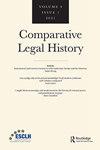美国海外法律教育——批判历史
IF 0.5
Q2 LAW
引用次数: 0
摘要
法律导言中没有提到为什么私法史被排除在外。尤其是英国财产法的接受似乎与原住民被剥夺财产和殖民化的历史密不可分——这在文本中得到了承认,但并没有真正探讨。也许人们期望在实质性课程中提供这样的历史背景?无论如何,作者在对该国最著名的合法出口之一托伦斯产权登记制度的起源进行非常简短的论述时,无意中证明了这种纳入可能带来的好处。在205,有一张1862年10月“Tanunda房地产法案节上的男人、女人和孩子”的照片(!)。一项小小的网络调查显示,在这场“异常奢华的活动”中,罗伯特·理查德·托伦斯爵士由“大约一百辆挂着国旗的马车护送,并举行宴会、乐队、合唱团、英语和德语演讲和祝酒词、彩灯和凯旋门”。这一切都是为了纪念赋予他的头衔不可撤销的新概念。谁说财产法的历史并不令人兴奋?作者们确实用许多生动的历史人物“客串”和戏剧性事件来美化他们的叙事,这些事件来自备受瞩目的案件和宪法斗争。我的观点只是,私法也可以这样做,因此,应该鼓励作者写一本配套的书。一代又一代的法律系学生会感谢他们。本文章由计算机程序翻译,如有差异,请以英文原文为准。
American legal education abroad–Critical histories
law. There is no mention in the introduction of why the history of private law was excluded. The reception of English property law in particular seems inseparable from the history of Aboriginal dispossession and colonization—something acknowledged but not really explored in the text. Perhaps it is expected that such historical background is provided in the substantive courses themselves? In any case, what might have been gained by such inclusion is inadvertently demonstrated by the authors in their very brief treatment of the origins of one of the country’s most famous legal exports, the Torrens system of title registration. At 205 there is a photo of ‘Men, Women and Children at the Tanunda Real Property Act Festival’(!) in October 1862. A little internet sleuthing reveals that at this ‘extraordinarily lavish affair’ Sir Robert Richard Torrens was accompanied by ‘an escort of around a hundred flag-bedecked wagons, [and] feted with banquets, bands, choirs, speeches and toasts in English and German, illuminations, and triumphal arches’. All in honour of the new concept of indefeasibility of title attributed to him. Who says the history of property law is not exciting? The authors do indeed embellish their narrative with many lively ‘cameos’ of historical figures and dramatic incidents drawn from high-profile cases and constitutional battles. My point is simply that the same could be done for private law and thus, that the authors should be encouraged to write a companion volume. Generations of law students would thank them.
求助全文
通过发布文献求助,成功后即可免费获取论文全文。
去求助
来源期刊
CiteScore
1.70
自引率
0.00%
发文量
20
期刊介绍:
Comparative Legal History is an international and comparative review of law and history. Articles will explore both ''internal'' legal history (doctrinal and disciplinary developments in the law) and ''external'' legal history (legal ideas and institutions in wider contexts). Rooted in the complexity of the various Western legal traditions worldwide, the journal will also investigate other laws and customs from around the globe. Comparisons may be either temporal or geographical and both legal and other law-like normative traditions will be considered. Scholarship on comparative and trans-national historiography, including trans-disciplinary approaches, is particularly welcome.

 求助内容:
求助内容: 应助结果提醒方式:
应助结果提醒方式:


